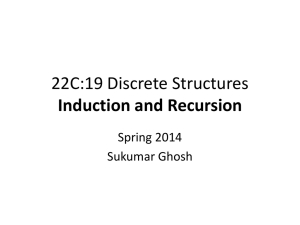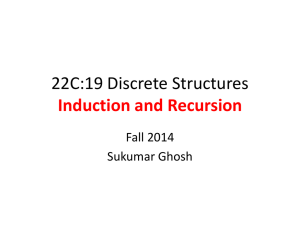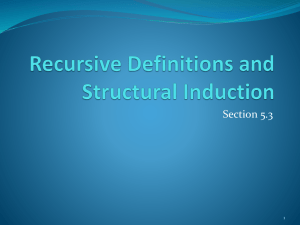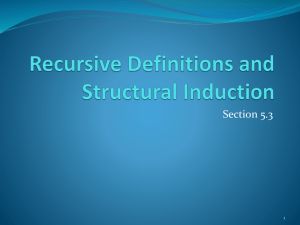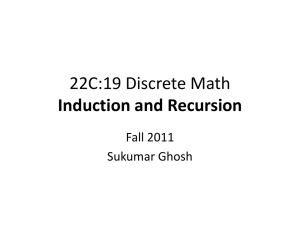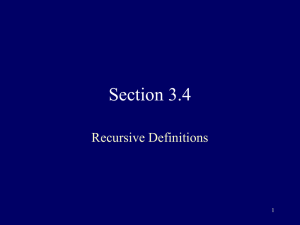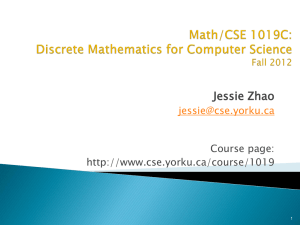slides
advertisement
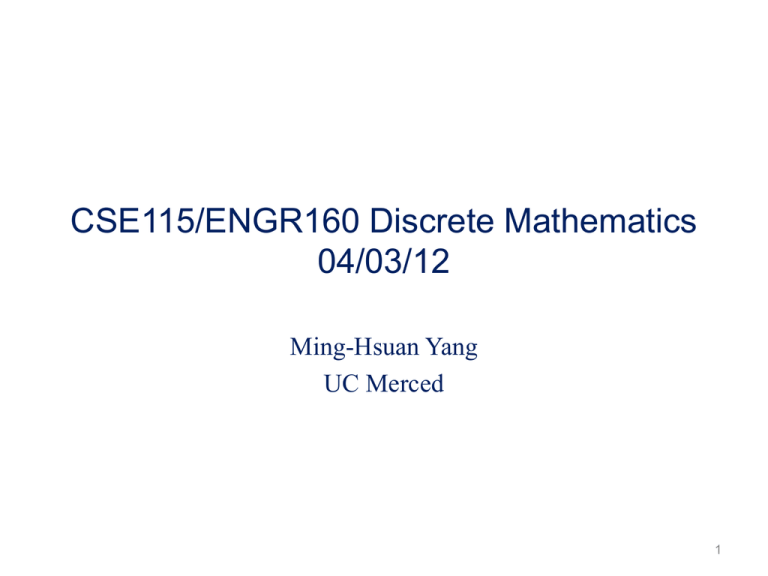
CSE115/ENGR160 Discrete Mathematics
04/03/12
Ming-Hsuan Yang
UC Merced
1
5.3 Recursive definitions and
structural induction
A recursively defined picture
2
Recursive definitions
• The sequence of powers of 2 is given by an=2n for
n=0, 1, 2, …
• Can also be defined by a0=1, and a rule for finding a
term of the sequence from the previous one, i.e.,
an+1=2an
• Can use induction to prove results about the
sequence
• Structural induction: We define a set recursively by
specifying some initial elements in a basis step and
provide a rule for constructing new elements from
those already in the recursive step
3
Recursively defined functions
• Use two steps to define a function with the set
of non-negative integers as its domain
• Basis step: specify the value for the function
at zero
• Recursive step: give a rule for finding its value
at an integer from its values at smaller
integers
• Such a definition is called a recursive or
inductive definition
4
Example
• Suppose f is defined recursively by
– f(0)=3
– f(n+1)=2f(n)+3
Find f(1), f(2), f(3), and f(4)
– f(1)=2f(0)+3=2*3+3=9
– f(2)=2f(1)+3=2*9+3=21
– f(3)=2f(2)+3=2*21+3=45
– f(4)=2f(3)+3=2*45+3=93
5
Example
• Give an inductive definition of the factorial
function f(n)=n!
• Note that (n+1)!=(n+1)∙n!
• We can define f(0)=1 and f(n+1)=(n+1)f(n)
• To determine a value, e.g., f(5)=5!, we can use
the recursive function
f(5)=5∙f(4)=5∙4∙f(3)=5∙4∙3∙f(2)=5∙4∙3∙2∙f(1)
=5∙4∙3∙2∙1∙f(0)=5∙4∙3∙2∙1∙1=120
6
Recursive functions
• Recursively defined functions are well defined
• For every positive integer, the value of the
function is determined in an unambiguous
way
• Given any positive integer, we can use the two
parts of the definition to find the value of the
function at that integer
• We obtain the same value no matter how we
apply two parts of the definition
7
Example
• Given a recursive definition of an, where a is a
non-zero real number and n is a non-negative
integer
• Note that an+1=a∙an and a0=1
• These two equations uniquely define an for all
non-negative integer n
8
Example
n
• Given a recursive definition of a
• The first part of the recursive definition
k 0
0
a
k 0
k
k
a0
• The second part is
n 1
a
k 0
n
k
( ak ) an 1
k 0
9
Example – Fibonacci numbers
• Fibonacci numbers f0, f1, f2, are defined by the
equations, f0=0, f1=1, and fn=fn-1+fn-2 for n=2, 3, 4, …
• By definition
f2=f1+f0=1+0=1
f3=f2+f1=1+1=2
f4=f3+f2=2+1=3
f5=f4+f3=3+2=5
f6=f5+f4=5+3=8
10
Example
• Use strong induction to show when n≥3, fn>𝛼n-2
where fn is a Fibonacci number and (1 5) / 2
• Let p(n) be the proposition that fn>𝛼n-2
• Basis step: note that
2 f3 , 2 (3 5) / 2 3 f 4
so that p(3) and p(4) are true
• Inductive step: assume p(j) is true, i.e., fj>𝛼j-2 with
3≤j ≤k where k≥4. We need to show that p(k+1)
is true, i.e., fk>𝛼k-2
11
Example
• First note that 𝛼 is a solution to x2-x-1=0, so
𝛼 2=𝛼+1, thus
k 1 2 k 3 ( 1) k 3 k 2 k 3
• By inductive hypothesis, if k≥4, it follows
fk-1>𝛼k-3 , fk>𝛼k-2
f k 1 f k f k 1 k 2 k 3 k 1
• So,
It follows that p(k+1) is true. This
completes the proof
12
Recursively defined sets and
structures
• Consider the subset S of the set of integers
defined by
– Basis step: 3∊S
– Recursive step: if x∊S and y∊S, then x+y∊S
• The new elements formed by this are
3+3=6, 3+6=9, 6+6=12, …
• We will show that S is the set of all positive
multiples of 3 (using structural induction)
13
String
• The set ∑* of strings over the alphabet ∑ can be defined
recursively by
– Basis step: 𝜆∊∑* (where 𝜆 is the empty string containing no
symbols)
– Recursive step: if w∊∑* and x∊∑ then wx ∊∑*
• The basis step defines that the empty string belongs to
string
• The recursive step states new strings are produced by
adding a symbol from ∑ to the end of stings in ∑*
• At each application of the recursive step, strings containing
one additional symbol are generated
14
Example
• If ∑={0, 1}, the strings found to be in ∑*, the
set of all bit strings, are
• 𝜆, specified to be in ∑* in the basis step
• 0 and 1 found in the 1st recursive step
• 00, 01, 10, and 11 are found in the 2nd
recursive step, and so on
15
Concatenation
• Two strings can be combined via the operation of
concatenation
• Let ∑ be a set of symbols and ∑* be the set of strings
formed from symbols in ∑
• We can define the concatenation for two strings by
recursive steps
– Basis step: if w∊∑*, then w∙𝜆=w, where 𝜆 is the empty string
– Recursive step: If w1∊∑*, w2∊∑* and x ∊∑, then w1 ∙ (w2 x)=(w1 ∙
w2)x
– Oftentimes w1 ∙ w2 is rewritten as w1w2
– e.g., w1=abra, and w2=cadabra, w1w2=abracadabra
16
Length of a string
• Give a recursive definition of l(w), the length
of a string w
• The length of a string is defined by
– l(𝜆)=0
– l(wx)=l(w)+1 if w∊∑* and x∊∑
17
Well-formed formulae
• We can define the set of well-formed formulae for compound
statement forms involving T, F, proposition variables and
operators from the set {┐, ˄, ˅, →, ↔}
• Basis step: T, F, and s, where s is a propositional variable
are well-formed formulae
• Recursive step: If E and F are well-formed formulae, then
┐E, E˄F, E ˅F, E→F, E ↔F are well-formed formulae
• From an initial application of the recursive step, we know that
(p˅q), (p→F), (F→q) and (q˄F) are well-formed formulae
• A second application of the recursive step shows that ((p˅q)
→(q˄F)), (q˅(p˅q)), and ((p→F)→T) are well-formed
formulae
18
Rooted trees
• The set of rooted trees, where a rooted tree consists
of a set of vertices containing a distinguished vertex
called the root, and edges connecting these vertices,
can be defined recursively by
– Basis step: a single vertex r is a rooted tree
– Recursive step: suppose that T1, T2, …, Tn are disjoint
rooted trees with roots r1, r2, …, rn, respectively.
– Then the graph formed by starting with a root r, which is
not in any of the rooted trees T1, T2, …, Tn, and adding an
edge from r to each of the vertices r1, r2, …, rn, is also a
rooted tree
19
Rooted trees
20
Binary trees
• At each vertex, there are at most two
branches (one left subtree and one right
subtree)
• Extended binary trees: the left subtree or the
right subtree can be empty
• Full binary trees: must have left and right
subtrees
21
Extended binary trees
• The set of extended binary trees can be
defined by
– Basis step: the empty set is an extended binary
tree
– Recursive step: If T1 and T2 are disjoint extended
binary trees, there is an extended binary tree,
denoted by T1 ∙ T2, consisting of a root r together
with edges connecting the root to each of the
roots of the left subtree T1 and right subtree T2,
when these trees are non-empty
22
Extended binary trees
23
Full binary trees
• The set of full binary trees can be defined
recursively
– Basis step: There is a full binary tree consisting
only of a single vertex r
– Recursive step: If T1 and T2 are disjoint full binary
trees, there is a full binary tree, denoted by T1 ∙ T2,
consisting of a root r together with edges
connecting the root to each of the roots of the
left subtree T1 and right subtree T2
24
Full binary tree
25
Structural induction
• Show that the set S defined by
– 3∊S and
– if x∊S and y∊S, then x+y∊S,
is the set of multiples of 3
• Let A be the set of all positive integers divisible by 3
• To prove A=S, we must show that A⊆S, and S⊆A
• To show A⊆S, we must show that every positive
integer divisible by 3 is in S
• Use mathematical induction to prove it
26
Structural induction
• Let p(n) be the statement that 3n belongs to S
• Basis step: it holds as the first part of recursive
definition of S, 3⋅1=3∊S
• Inductive step: assume that p(k) is true, i.e.,
3k is in S. As 3k∊S and 3∊S, it follows from
the 2nd part of the recursive definition of S
that 3k+3=3(k+1)∊S. So p(k+1) is true
27
Structural induction
• To show that S⊆A, we use recursive definition of S
• The basis step of the definition specifies that 3 is in S
• As 3=3⋅1, all elements specified to be in S in this step are
divisible by 3, and there in A
• To finish the proof, we need to show that all integers in S
generated using the 2nd part of the recursive definition are
in A
• This consists of showing that x+y is in A whenever x and y are
elements of S also assumed to be in A
• If x and y are both in A, it follows that 3|x, 3|y, and thus
3|x+y, thereby completing the proof
28
Trees and structural induction
• To prove properties of trees with structural
induction
– Basis step: show that the result is true for the tree
consisting of a single vertex
– Recursive step: show that if the result is true for
the trees T1 and T2, then it is true for T1⋅T2,
consisting of a root r, which has T1 as its left
subtree and T2 as its right subtree
29
Height of binary tree
• We define the height h(T) of a full binary tree
T recursively
– Basis step: the height of the full binary tree T
consisting of only a root r is h(T)=0
– Recursive step: If T1 and T2 are full binary trees,
then the full binary tree T= T1⋅ T2 has height
h(T)=1+max(h(T1), h(T2))
30
Number of vertices in a binary tree
• If we let n(T) denote the number of vertices in
a full binary tree, we observe that n(T)
satisfies the following recursive formula:
– Basis step: the number of vertices n(T) of the full
binary tree consisting of only a root r is n(T)=1
– Recursive step: If T1 and T2 are full binary trees,
then the number of vertices of the full binary tree
T= T1⋅ T2 is n(T)=1+n(T1)+n(T2)
31
Theorem
• If T is a full binary tree T, then n(T)≤2h(T)+1-1
• Use structural induction to prove this
• Basis step: for the full binary tree consisting of
just the root r the result is true as n(T)=1 and
h(T)=0, so n(T)=1≤20+1-1=1
• Inductive step: For the inductive hypothesis
h (T ) 1
h (T ) 1
n
(
T
)
2
1
,
n
(
T
)
2
1
we assume that 1
2
where T1 and T2 are full binary trees
1
2
32
Theorem
• By the recursive formulae for n(T) and h(T), we have
n(T)=1+n(T1)+n(T2) and h(T)=1+max(h(T1), h(T2))
• Thus,
n(T ) 1 n(T ) n(T )
1
2
1 (2 h (T1 ) 1 1) (2 h (T2 ) 1 1)
2 max(2 h (T1 ) 1 ,2 h (T2 ) 1 ) 1
2 2 max(h (T1 ),h (T2 )) 1 1
2 2 h (T ) 1
2 h (T ) 1 1
• This completes the inductive step
33
